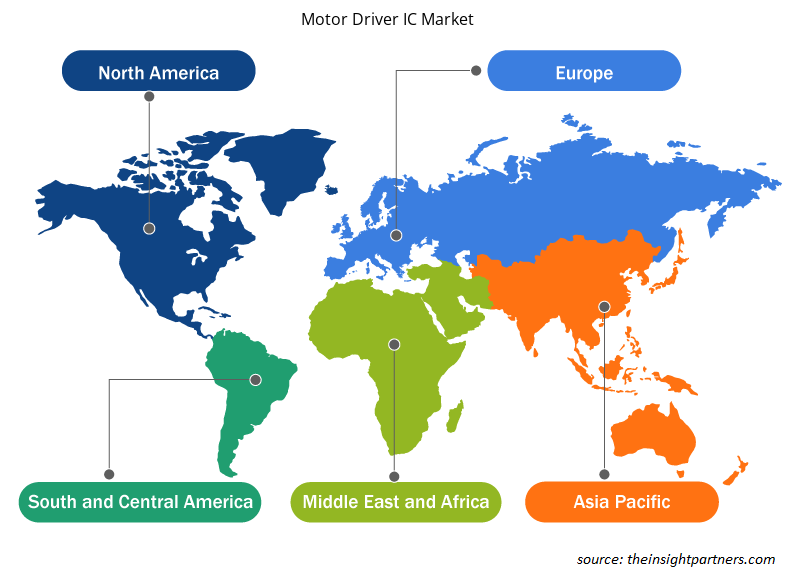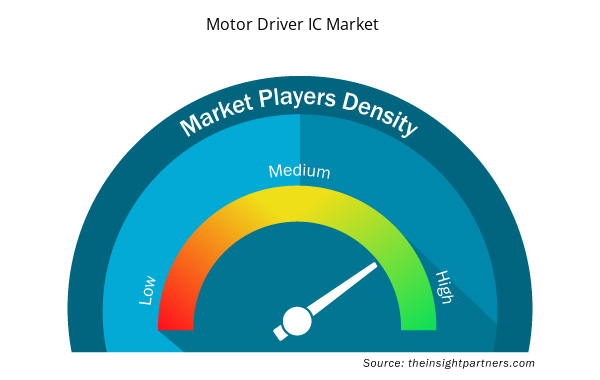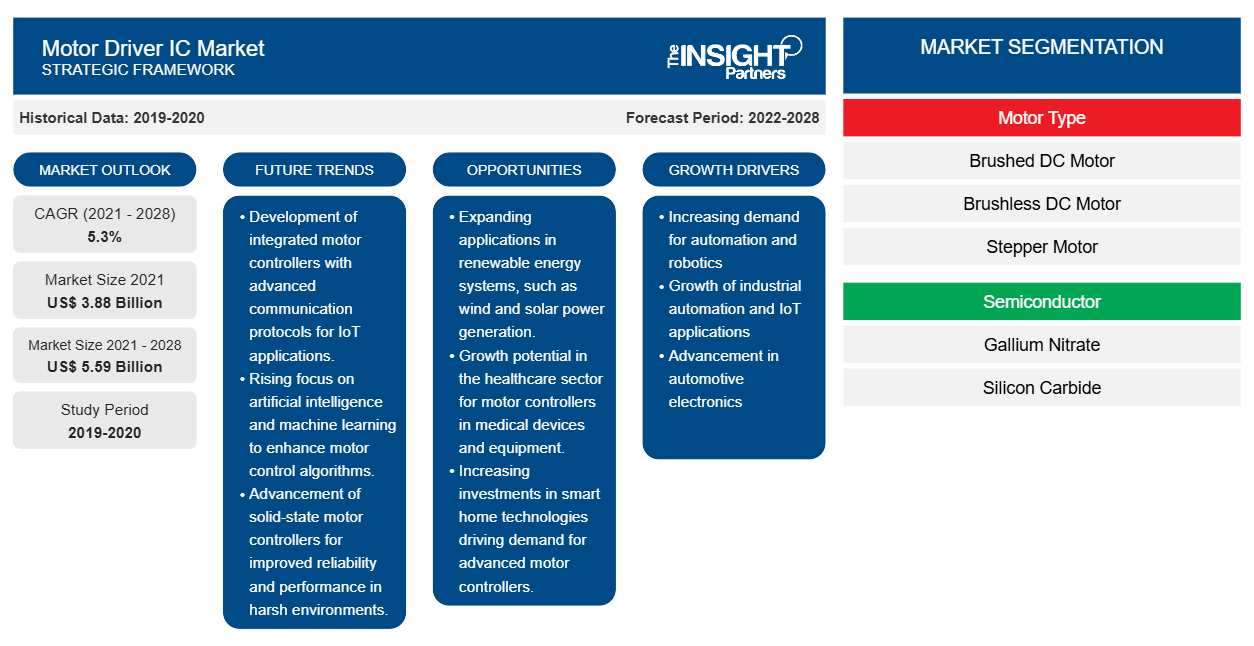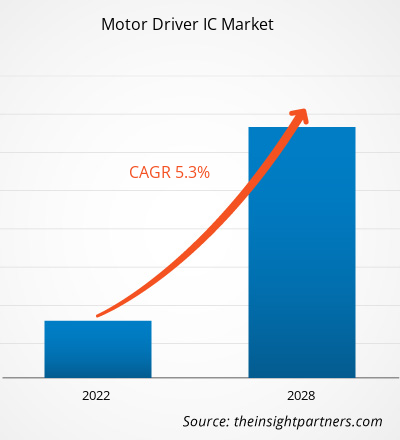[研究报告] 电机驱动IC市场预计将从2021年的38.8257亿美元增长到2028年的55.8933亿美元;预计2021年至2028年的复合年增长率为5.3%。
电机驱动器集成电路 (IC) 是一种电子元件,用于调节和利用发送到电机的电力。该 IC 有助于根据需要为电机提供足够的电力。它在工业、汽车、医疗和消费电子行业的旋转电机电源管理和控制方面有着广泛的应用。电机驱动器 IC 用于汽车和医疗等各个领域。消费电子产品需求的激增以及半导体行业在人工智能应用、设备设计、芯片性能和制造价格方面的重大进步预计将为电机驱动器 IC 市场的主要参与者提供盈利前景
智能家居设备在美国、日本、意大利、德国和法国等发达经济体中越来越受欢迎。电机驱动器 IC 大量融入智能家居技术产品中,例如游戏机、机器人吸尘器和智能 HVAC系统。此外,将 AI 和 IoT 技术集成到智能家居设备中将在整个预测期内促进市场扩张。
定制此报告以满足您的需求
您可以免费定制任何报告,包括本报告的部分内容、国家级分析、Excel 数据包,以及为初创企业和大学提供优惠和折扣
- 获取此报告的关键市场趋势。这个免费样品将包括数据分析,从市场趋势到估计和预测。
根据 Care Ratings 的调查,由于本财年需求下降,消费电子和家电制造商计划在 2022 财年将产量提高 5% 至 8%。预计 2022 财年的产量将增长 5% 至 8%。预计在家办公文化的兴起将推动消费电子产品需求的增长。此外,基于农村收入的增加和政府与农村电气化相关的计划,农村地区对消费电子产品的需求激增。由于消费电子产品产量的增加,对其基本组件和设备(例如电机驱动器 IC)的需求也将增加,从而导致市场扩大。
COVID-19 疫情对电机驱动 IC 市场的影响
新冠疫情对电机驱动 IC 业务产生了影响,导致许多工厂关闭、供应链出现问题、国际贸易受阻。由于半导体短缺加剧,电机驱动 IC 的市场潜力降低,多家汽车制造商在 2020 年初降低了生产能力。然而,由于全球封锁措施的放松,电机驱动 IC 市场在 2020 年第三季度获得了发展势头,导致市场在 2020 年底取得了积极成果。
市场洞察
物联网 (IoT) 在各行各业的应用日益广泛
工业 4.0 是最新的工业革命,将自动化、大数据和人工智能引入世界各地的工厂。物联网 (IoT) 是工业 4.0的基础之一。工业物联网 (IIoT) 使用联网传感器和智能设备收集数据,用于生产车间的人工智能和预测分析。物联网 (IoT) 改变了大多数工业流程的执行方式,包括产品的生产和分销方式、从对人类操作员来说过于危险的区域收集数据的方式以及如何维护产品质量。同样,在人口不断增长的情况下,IIoT 一直是提高农业生产力和降低成本的驱动因素。多项研究表明,在不久的将来,农场运营中将更多地采用由物联网驱动的智能解决方案。研究表明,农业领域的物联网设备安装量将以 20% 的复合年增长率增长,到 2024 年,联网设备(农业)数量将达到 2.25 亿。因此,物联网在各个领域的影响力不断扩大,对电机驱动 IC 制造商来说是个好兆头,从而增加客户群。
半导体细分市场洞察
根据半导体,电机驱动器 IC 市场分为硝酸镓 (GaN) 和碳化硅 (SiC)。碳化硅 (SiC) 半导体在许多关键应用中比普通半导体更有效。因此,新技术特别受到电动汽车制造商的关注,例如增强电池控制。因此,SiC 半导体有助于节约能源,大大提高了电动汽车的续航里程。使用基于 SiC 的半导体还可以实现快速充电。现在每辆电动汽车都包含大量半导体。凭借其开关速度快、散热好、尺寸小等优势,SiC 型半导体领域未来的需求将会增加。
此外,喷砂喷射器、汽车水泵密封件、轴承、泵组件和挤压模具都是 SiC 应用的例子,这些应用依赖于碳化硅的卓越硬度、耐磨性和耐腐蚀性。
电机类型细分洞察
根据电机类型,全球电机驱动器 IC 市场分为有刷直流电机、无刷直流电机和步进电机。无刷直流 (BLDC) 电机在市场上以及各种运动控制应用中的采用正在迅速增加,因为它们与传统有刷直流电机相比具有明显的优势,例如维护成本更低、运行速度更快、更紧凑、电气噪声更低以及扭矩重量比更好。尽管有这些优势,BLDC 电机比普通直流电机更昂贵,因为它们需要电机驱动控制器和转子位置传感器。在工业定位和驱动应用中,采用无刷电机。无刷步进或伺服电机用于装配机器人,以定位要组装的零件或用于焊接或喷漆等工业过程的工具。线性执行器也可以由无刷电机驱动。然而,BLDC 电机驱动设计的新趋势正在解决成本障碍,并使这些驱动器比普通直流电机更高效地运行。 BLDC 电机驱动技术的另一个关键发展是将 BLDC 电机和驱动电子设备组合成一个封装,以简化系统、消除连接布线并解决电机驱动兼容性困难。
应用程序细分洞察
根据应用,全球电机驱动器 IC 市场细分为制造业、航空航天和国防、工业自动化、消费电子和家用电器、医疗保健等。制造业、石油和天然气、能源和电力、食品和饮料、农业等是采用工业自动化的最常见行业。工业自动化主要依靠工业交流驱动器和伺服驱动器来满足对动态行为和准确性日益增长的期望。对实时数据的巨大需求,需要使用具有卓越功能的系统。因此,这些高性能电机控制系统核心的微处理器可以立即计算级联控制任务,并以精确度检测电流、位置和速度。各公司正在为工业自动化提供一系列独家电机驱动器 IC。例如,英飞凌的电机控制解决方案,如我们的 OptiMOSTM 和 CoolMOSTM MOSFET、电源控制 IC 和 EiceDRIVERTM 栅极驱动器,可以帮助改善工业自动化应用。
市场参与者专注于新产品的创新和开发,通过整合先进技术和功能来与竞争对手竞争。2021 年 11 月,On Semi 完成了对碳化硅 (SiC) 制造商 GT Advanced Technologies 的收购。此次收购提高了 Onsemi 确保和增加 SiC 供应的能力。Onsemi 致力于在颠覆性、高增长技术上进行大量投资,以实现差异化和领导地位,尤其是在 SiC 生态系统中,此次收购进一步加强了这一承诺。
根据半导体,电机驱动器 IC 市场分为硝酸镓 (GaN) 和碳化硅 (SiC)。根据电机类型,全球电机驱动器 IC 市场分为有刷直流电机、无刷直流电机和步进电机。根据应用,全球电机驱动器 IC 市场分为制造业、航空航天和国防、工业自动化、消费电子和家用电器、医疗保健等。根据地区,全球电机驱动器 IC 市场分为北美、欧洲、亚太地区、中东和非洲以及南美。
电机驱动器 IC 市场区域洞察
Insight Partners 的分析师已详细解释了预测期内影响电机驱动器 IC 市场的区域趋势和因素。本节还讨论了北美、欧洲、亚太地区、中东和非洲以及南美和中美洲的电机驱动器 IC 市场细分和地理位置。

- 获取电机驱动器 IC 市场的区域特定数据
电机驱动 IC 市场报告范围
| 报告属性 | 细节 |
|---|---|
| 2021 年市场规模 | 38.8亿美元 |
| 2028 年市场规模 | 55.9亿美元 |
| 全球复合年增长率(2021 - 2028) | 5.3% |
| 史料 | 2019-2020 |
| 预测期 | 2022-2028 |
| 涵盖的领域 | 按电机类型
|
| 覆盖地区和国家 | 北美
|
| 市场领导者和主要公司简介 |
|
电机驱动器 IC 市场参与者密度:了解其对业务动态的影响
电机驱动器 IC 市场正在快速增长,这得益于终端用户需求的不断增长,这些需求源于消费者偏好的不断变化、技术进步以及对产品优势的认识不断提高等因素。随着需求的增加,企业正在扩大其产品范围,进行创新以满足消费者的需求,并利用新兴趋势,从而进一步推动市场增长。
市场参与者密度是指在特定市场或行业内运营的企业或公司的分布情况。它表明在给定市场空间中,相对于其规模或总市场价值,有多少竞争对手(市场参与者)存在。
在电机驱动器 IC 市场运营的主要公司有:
- Allegro 微系统公司
- Dialog 半导体公司
- 三菱电机公司
- 安森美半导体
- 罗姆有限公司
免责声明:上面列出的公司没有按照任何特定顺序排列。

- 获取电机驱动器 IC 市场顶级关键参与者概览
电机驱动 IC 市场 – 公司简介
- 东芝公司
- 三菱电机公司
- 德州仪器 (TI)
- Allegro 微系统公司
- 戴乐格半导体公司
- 意法半导体
- 安森美半导体
- 罗姆株式会社
- 英飞凌科技股份公司
- ADI 公司
- 历史分析(2 年)、基准年、预测(7 年)及复合年增长率
- PEST 和 SWOT 分析
- 市场规模价值/数量 - 全球、区域、国家
- 行业和竞争格局
- Excel 数据集



Report Coverage
Revenue forecast, Company Analysis, Industry landscape, Growth factors, and Trends

Segment Covered
This text is related
to segments covered.

Regional Scope
North America, Europe, Asia Pacific, Middle East & Africa, South & Central America

Country Scope
This text is related
to country scope.
常见问题
According to a survey by Care Ratings, consumer electronics and appliances manufacturers are planning to raise production by 5% to 8% in FY2022, following a drop in demand in the current fiscal. Production is predicted to climb between 5% and 8% in FY2022. The rise in demand for consumer electronics is projected to be aided by the rise in work-from-home culture. Moreover, based on increased rural earnings and government programs related to rural electrification, there is a surge in demand for consumer electronics in rural areas. Due to the growing production of consumer electronics, the demand for their basic components and devices such as motor driver ICs will also increase, resulting in market expansion.
Semiconductor firms are lobbying electric vehicle manufacturers to abandon standard silicon chips in favor of materials to improve vehicle efficiency while also easing customer concerns. Choosing the appropriate technology has never been more important than now, as the auto industry faces its most significant shift in almost a century. Manufacturers worldwide are rushing to eliminate internal combustion engines, and even gasoline-powered icons like Ford's Mustang and GMC's Hummer are receiving battery-powered versions. Hence, due to the shift, the automotive industry is likely to be the go-to-market for motor driver IC manufacturers.
The major companies in the motor driver IC and services include Texas Instruments, Analogic Devices, STMicroelectronics, Infineon Technologies AG, and Renesas Electronics.
The global motor driver IC and services market was dominated by the brushless DC motor segment in 2020, which accounted for more than 45% of the market share. Brushless DC (BLDC) motors have seen rapid adoption in the marketplace and across a wide range of motion control applications, owing to their distinct advantages over traditional brushed DC motors, which include lower maintenance, higher operating speeds, compactness, lower electrical noise, and better torque-to-weight ratios, to name a few.
The global motor driver IC and services market was dominated by the silicon carbide (SiC) segment in 2020, which accounted for a major market share. Silicon carbide (SiC) semiconductors are more effective than ordinary semiconductors in a number of key applications. As a result, the new technology is of special interest to electric vehicle manufacturers such as enhanced battery control, owing to SiC semiconductors, which helps preserve energy, substantially improving the range of electric vehicles. Faster recharging is also possible using SiC-based semiconductors.
In 2020, Asia Pacific led the market with a substantial revenue share, followed by North America and Europe. Asia Pacific is a prospective market for motor driver IC manufacturers.
Trends and growth analysis reports related to Electronics and Semiconductor : READ MORE..
The List of Companies - Motor Driver IC Market
- Allegro Microsystems
- Dialog Semiconductor PLC,
- Mitsubishi Electric Corporation
- ON Semiconductor
- Rohm Co Ltd,
- Analog Devices
- STMicroelctronics
- Texas Instruments
- Toshiba Corporation
The Insight Partners performs research in 4 major stages: Data Collection & Secondary Research, Primary Research, Data Analysis and Data Triangulation & Final Review.
- Data Collection and Secondary Research:
As a market research and consulting firm operating from a decade, we have published and advised several client across the globe. First step for any study will start with an assessment of currently available data and insights from existing reports. Further, historical and current market information is collected from Investor Presentations, Annual Reports, SEC Filings, etc., and other information related to company’s performance and market positioning are gathered from Paid Databases (Factiva, Hoovers, and Reuters) and various other publications available in public domain.
Several associations trade associates, technical forums, institutes, societies and organization are accessed to gain technical as well as market related insights through their publications such as research papers, blogs and press releases related to the studies are referred to get cues about the market. Further, white papers, journals, magazines, and other news articles published in last 3 years are scrutinized and analyzed to understand the current market trends.
- Primary Research:
The primarily interview analysis comprise of data obtained from industry participants interview and answers to survey questions gathered by in-house primary team.
For primary research, interviews are conducted with industry experts/CEOs/Marketing Managers/VPs/Subject Matter Experts from both demand and supply side to get a 360-degree view of the market. The primary team conducts several interviews based on the complexity of the markets to understand the various market trends and dynamics which makes research more credible and precise.
A typical research interview fulfils the following functions:
- Provides first-hand information on the market size, market trends, growth trends, competitive landscape, and outlook
- Validates and strengthens in-house secondary research findings
- Develops the analysis team’s expertise and market understanding
Primary research involves email interactions and telephone interviews for each market, category, segment, and sub-segment across geographies. The participants who typically take part in such a process include, but are not limited to:
- Industry participants: VPs, business development managers, market intelligence managers and national sales managers
- Outside experts: Valuation experts, research analysts and key opinion leaders specializing in the electronics and semiconductor industry.
Below is the breakup of our primary respondents by company, designation, and region:

Once we receive the confirmation from primary research sources or primary respondents, we finalize the base year market estimation and forecast the data as per the macroeconomic and microeconomic factors assessed during data collection.
- Data Analysis:
Once data is validated through both secondary as well as primary respondents, we finalize the market estimations by hypothesis formulation and factor analysis at regional and country level.
- Macro-Economic Factor Analysis:
We analyse macroeconomic indicators such the gross domestic product (GDP), increase in the demand for goods and services across industries, technological advancement, regional economic growth, governmental policies, the influence of COVID-19, PEST analysis, and other aspects. This analysis aids in setting benchmarks for various nations/regions and approximating market splits. Additionally, the general trend of the aforementioned components aid in determining the market's development possibilities.
- Country Level Data:
Various factors that are especially aligned to the country are taken into account to determine the market size for a certain area and country, including the presence of vendors, such as headquarters and offices, the country's GDP, demand patterns, and industry growth. To comprehend the market dynamics for the nation, a number of growth variables, inhibitors, application areas, and current market trends are researched. The aforementioned elements aid in determining the country's overall market's growth potential.
- Company Profile:
The “Table of Contents” is formulated by listing and analyzing more than 25 - 30 companies operating in the market ecosystem across geographies. However, we profile only 10 companies as a standard practice in our syndicate reports. These 10 companies comprise leading, emerging, and regional players. Nonetheless, our analysis is not restricted to the 10 listed companies, we also analyze other companies present in the market to develop a holistic view and understand the prevailing trends. The “Company Profiles” section in the report covers key facts, business description, products & services, financial information, SWOT analysis, and key developments. The financial information presented is extracted from the annual reports and official documents of the publicly listed companies. Upon collecting the information for the sections of respective companies, we verify them via various primary sources and then compile the data in respective company profiles. The company level information helps us in deriving the base number as well as in forecasting the market size.
- Developing Base Number:
Aggregation of sales statistics (2020-2022) and macro-economic factor, and other secondary and primary research insights are utilized to arrive at base number and related market shares for 2022. The data gaps are identified in this step and relevant market data is analyzed, collected from paid primary interviews or databases. On finalizing the base year market size, forecasts are developed on the basis of macro-economic, industry and market growth factors and company level analysis.
- Data Triangulation and Final Review:
The market findings and base year market size calculations are validated from supply as well as demand side. Demand side validations are based on macro-economic factor analysis and benchmarks for respective regions and countries. In case of supply side validations, revenues of major companies are estimated (in case not available) based on industry benchmark, approximate number of employees, product portfolio, and primary interviews revenues are gathered. Further revenue from target product/service segment is assessed to avoid overshooting of market statistics. In case of heavy deviations between supply and demand side values, all thes steps are repeated to achieve synchronization.
We follow an iterative model, wherein we share our research findings with Subject Matter Experts (SME’s) and Key Opinion Leaders (KOLs) until consensus view of the market is not formulated – this model negates any drastic deviation in the opinions of experts. Only validated and universally acceptable research findings are quoted in our reports.
We have important check points that we use to validate our research findings – which we call – data triangulation, where we validate the information, we generate from secondary sources with primary interviews and then we re-validate with our internal data bases and Subject matter experts. This comprehensive model enables us to deliver high quality, reliable data in shortest possible time.


 获取此报告的免费样本
获取此报告的免费样本